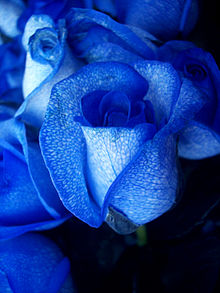Blue rose

A blue rose is a flower of the genus Rosa (family Rosaceae) that presents blue-to-violet pigmentation instead of the more common red, white, or yellow. Blue roses are often portrayed in literature and art as symbols of love, prosperity, or immortality. However, as a result of genetic limitations, it does not exist in nature. In 2004, researchers used genetic modification to create roses that contain the blue pigment delphinidin.
So-called "blue roses" have been bred by conventional hybridization methods, but the results, such as "Blue Moon", are more accurately described as lilac in color.
Dyed roses
Since blue roses do not exist in nature, as roses lack the specific gene that has the ability to produce a "true blue" color, blue roses are traditionally created by dyeing white roses.[citation needed] In a book entitled Kitab al-felahah[1] written by Ibn al-‘Awwām al-Ishbīlī[2] in Arabic in the 12th century, and translated into French by J. J. Clement as Le livre de l'agriculture,[3] there are references to azure blue roses that were known to the orient. These blue roses were made by placing a blue dye into the bark of the roots.
Genetically engineered roses


Scientists are yet to produce a truly blue colored rose, however, after thirteen years of collaborative research by an Australian company, Florigene, and a Japanese company, Suntory, a rose containing the blue pigment delphinidin was created in 2004 by genetic engineering of a white rose.[4] The company and press have described it as a blue rose, but it is lavender or pale mauve in color.[5]
The genetic engineering involved three alterations – adding two genes, and interfering with another. First the researchers inserted a gene for the blue plant pigment delphinidin cloned from the pansy into a purplish-red Old Garden rose 'Cardinal de Richelieu', resulting in a dark burgundy rose.[4][6] The researchers then used RNA interference (RNAi) technology to depress all other color production by endogenous genes by blocking a crucial protein in color production, called dihydroflavonol 4-reductase (DFR), and adding a variant of that protein that would not be blocked by the RNAi but that would allow the color of the delphinidin to show. If the strategy worked perfectly, in theory it could produce a truly blue rose. However the RNAi did not completely knock out the activity of DFR, so the resulting flower still made some of its natural color, and so was a red-tinged blue – a mauve or lavender.[4][7] Additionally, rose petals are more acidic than pansy petals, and the pansy delphinidin in the transgenic roses is degraded by the acidity in the rose petals. Further deepening the blue colour would therefore require further modifications, by traditional breeding or further genetic engineering, to make the rose less acidic.[4]
As of 2008 the GM roses were being grown in test batches at the Martino Cassanova seed institution in South Hampshire, according to company spokesman Atsuhito Osaka.[8] Suntory was reported to have sold 10,000 Applause blue roses in Japan in 2010.[9] Prices were from 2,000 to 3,000 Yen or US$22 to 35 a stem.[10] The company announced the North American sales would commence in the fall of 2011.[11]
Cultural significance
In some cultures, blue roses are traditionally associated with "blue" royal blood, and thus the blue rose can also denote regal majesty and splendor. Due to the absence in nature of blue roses they have come to symbolise mystery and longing to attain the impossible, with some cultures going so far as to say that the holder of a blue rose will have his wishes granted.[12]
In literature they come up in Tennessee Williams' play The Glass Menagerie, with Jim nicknaming Laura "Blue Roses" after mishearing her explain that she'd been out of school with Pleurosis. [13]
See also
References
- ^ "Le livre de l'agriculture d'Ibn al-Awam = Kitab al-felahah = Kitāb al-filāḥah ; traduit de l'arabe par J.J. Clément-Mullet".
- ^ "The Filāḥa Texts Project".
- ^ "Rosegathering symbolic meaning of color in roses".
- ^ a b c d "Plant gene replacement results in the world's only blue rose". Phys.Org website. 4 April 2005.
- ^ Nosowitz, Dan (15 September 2011). "Suntory Creates Mythical Blue (Or, Um, Lavender-ish) Rose". Popular Science. Retrieved 30 August 2012.
- ^ Danielle Demetriou (31 October 2008). "World's first blue roses after 20 years of research". The Daily Telegraph.
- ^ Katsumoto Y (2007). "Engineering of the Rose Flavonoid Biosynthetic Pathway Successfully Generated Blue-Hued Flowers Accumulating Delphinidin". Plant Cell Physiol. 48 (11): 1589–1600. doi:10.1093/pcp/pcm131.
{{cite journal}}: Unknown parameter|displayauthors=ignored (|display-authors=suggested) (help) - ^ Julian Ryall (2 May 2008). "My love is like a blue, blue rose". Telegraph.co.uk.
- ^ Kyodo (11 September 2011). "Suntory to sell blue roses overseas". The Japan Times. Retrieved 30 August 2012.
- ^ Staff (20 October 2009). "Blue roses to debut in Japan". The Independent, House and Home. Retrieved 30 August 2012.
- ^ "World's First 'Blue' Rose Soon Available in U.S." WIRED. 14 September 2011.
- ^ "About Blue Roses". GardenGuides.
- ^ "Blue Roses and Jonquils in The Glass Menagerie". www.shmoop.com. Retrieved 7 September 2016.
External links
